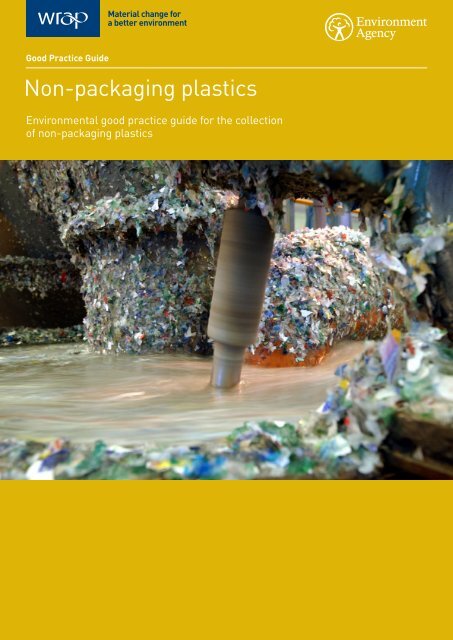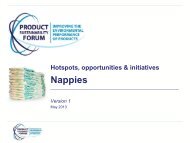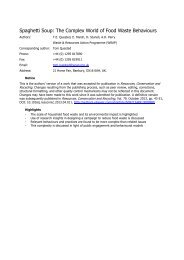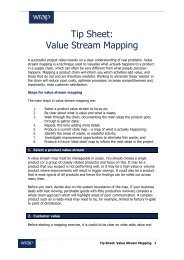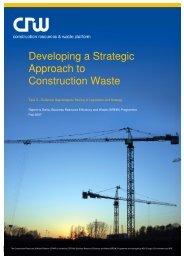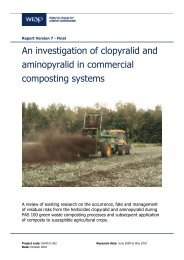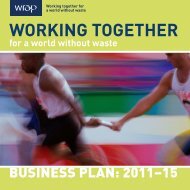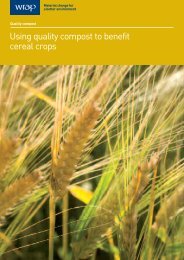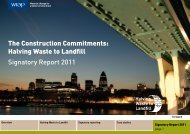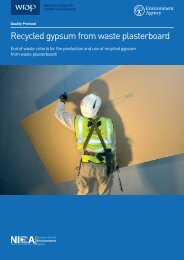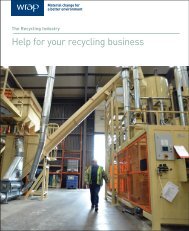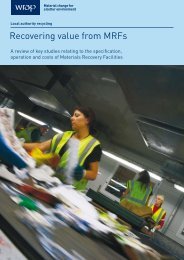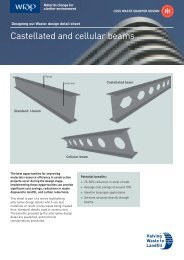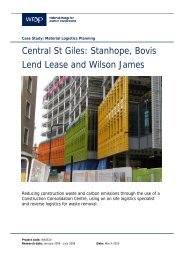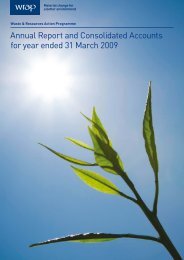non-packaging plastics environmental good practice guide ... - Wrap
non-packaging plastics environmental good practice guide ... - Wrap
non-packaging plastics environmental good practice guide ... - Wrap
- No tags were found...
You also want an ePaper? Increase the reach of your titles
YUMPU automatically turns print PDFs into web optimized ePapers that Google loves.
Training staffleads to greaterawarenessof importantsegregationand bio-securitymeasuresand facilitatescollection andrecovery.
Non-<strong>packaging</strong> <strong>plastics</strong> – Good Practice Guide 06Non-<strong>packaging</strong> <strong>plastics</strong> fromconstruction & demolitionNon-<strong>packaging</strong> plastic waste from construction and demolition fallin to three categories:n damaged materials and off cuts;n excess materials; andn demolition waste.As with other sources of <strong>non</strong>-<strong>packaging</strong> plastic waste, contaminationand mixing of polymers should be minimised wherever possible toensure the market for the material is not reduced and to maximiseits value.In order to minimise the mixing of polymers from construction sourcescollectors should:n determine the needs of the <strong>plastics</strong> reprocessor - is it suitablefor single polymer only or can a mix be tolerated?n communicate the importance of segregation to site managersand encourage staff training; andn place containers in easily accessed areas to maximise recoveryrate.To minimise contamination levels in <strong>non</strong>-<strong>packaging</strong> <strong>plastics</strong> fromconstruction sources collectors should:n communicate the importance of preventing contaminationto the site manager and encourage staff training;n provide lockable containers and request that they are storedin a secure area;n mark the containers with descriptions of acceptable and<strong>non</strong>-acceptable waste; andn empty containers on a regular basis.Further informationRecovinyl is a scheme that provides financial incentives tosupport the collection and recycling of PVC across the EuropeanUnion from waste streams that are not currently covered underproducer responsibility regulations. More information on thescheme and contact details for the UK can be found atwww.recovinyl.comRemoving the wastetag from <strong>non</strong>-<strong>packaging</strong><strong>plastics</strong> makes themmore marketable.
Non-<strong>packaging</strong> <strong>plastics</strong> – Good Practice Guide 08Non-<strong>packaging</strong> <strong>plastics</strong> from endof life vehicles (ELVs)Around 11% of the weight of an average car is made up of <strong>plastics</strong> thatcan potentially be recovered and recycled at the end of a vehicle’s life.The End of Life Vehicle Regulations (2003) identify the requirementsand minimum technical standards for sites that treat or store ELVs.To recover single polymer <strong>plastics</strong> from ELVs, collectors will need towork with vehicle dismantlers to provide guidance on the identificationand recovery of <strong>non</strong>-<strong>packaging</strong> <strong>plastics</strong> from vehicles. Collectors canimprove the separation of polymers and minimise contamination fromvehicle dismantling sites by taking the following measures:n determine the needs of the <strong>plastics</strong> reprocessor - is it suitablefor single polymer only or can a mix be tolerated?nnnnliaise with the vehicle dismantling site manager and encouragethem to train their staff in the identification of polymers and theimportance of minimising contamination;provide a guidance list of plastic components that are madeof the polymer you wish to collect;place lockable containers in nearby and easily accessed areasto maximise the recovery; andclearly mark the containers with descriptions of acceptable and<strong>non</strong>-acceptable waste and empty them as often as possible.Non-<strong>packaging</strong> <strong>plastics</strong> recovered from vehicle dismantling sitesare often large and bulky whilst being relatively light weight, forexample bumpers and dashboards. This can create handlingproblems and reduce the efficiency of collection systems. Collectorsshould therefore consider shredding, chipping or compactingrecovered plastic components on site to increase the volume thatcan be transported and delivered to the <strong>plastics</strong> reprocessorin one movement.Around 11% of the weightof an average car is madeup of <strong>plastics</strong> that canpotentially be recoveredand recycled at the endof a vehicle’s life.
Non-<strong>packaging</strong><strong>plastics</strong> arerecyclable and canbe reprocessed tomanufacture adiverse range ofproducts with a wholerange of potentialend uses.
Non-<strong>packaging</strong> <strong>plastics</strong> – Good Practice Guide 10Non-<strong>packaging</strong> <strong>plastics</strong> from wasteelectrical and electronic equipment(WEEE)The main sources of <strong>non</strong>-<strong>packaging</strong> <strong>plastics</strong> from waste electricaland electronic equipment (WEEE) are:n single polymer streams from manual dismantling systems; andn mixed polymer streams from bulk shredding of WEEE.There are a number of potential problems with recycling<strong>non</strong>-<strong>packaging</strong> <strong>plastics</strong> that are recovered from WEEE. The WasteElectrical and Electronic Equipment Regulations 2006, set outby the Waste Management Licensing for England and Wales (asamended), require that potentially hazardous brominated flameretardant (BFR), used as additives in some plastic products, beremoved before recycling.Important note:It is difficult to identify materials containing BFR as they are rarelymarked and specialist analytical equipment is required. It is thereforevital that the collector takes measures to identify whether or notit contains BFR and identify an end market for the material beforecollection. BFR is mainly found in WEEE <strong>plastics</strong> but may also bepresent in <strong>non</strong>-<strong>packaging</strong> <strong>plastics</strong> used in buildings and vehicles.Collectors should take the following measures to prevent theprocessing of polymers containing BFRs:n determine whether the <strong>non</strong>-<strong>packaging</strong> plastic contains BFR.If so, the waste must be treated to remove the BFR before it canbe recycled;nn<strong>non</strong>-<strong>packaging</strong> <strong>plastics</strong> containing BFR are classified as hazardouswaste and therefore the Hazardous Waste Regulations Directive2005 will apply; andcollectors of WEEE <strong>non</strong>-<strong>packaging</strong> <strong>plastics</strong> should identify anend market (such as a <strong>plastics</strong> reprocessor or a companyoperating a polymer separation facility) before undertaking thecollection.At present much of the <strong>non</strong>-<strong>packaging</strong> <strong>plastics</strong> recovered fromWEEE are produced by large scale, bulk shredding facilities, resultingin a mixed stream of polymers. These can be highly contaminatedwith <strong>non</strong>-plastic materials including dust, metal and glass and oftenneed to be pre-treated to remove these materials before processing.Cleaner, single stream polymers are produced by manual dismantlingsystems but this is labour intensive.Sensible managementof <strong>non</strong>-<strong>packaging</strong> plasticwaste leads to positive<strong>environmental</strong> andeconomic impacts.
11 Non-<strong>packaging</strong> <strong>plastics</strong> – Good Practice GuideAppendix: Sources of furtherinformationGeneral guidance on recycling <strong>non</strong>-<strong>packaging</strong> <strong>plastics</strong>Recoup at www.recoup.org. Recoup has a searchabledatabase of UK <strong>plastics</strong> reprocessors that can be found atwww.recoup.org/business/default.aspTel 01733 390 021WRAP at www.wrap.org.ukTel 01295 819900The British Plastics Federation at www.bpf.co.ukTel 020 7457 5000Envirowise at www.envirowise.org.ukTel 0800 585 794Identifying <strong>plastics</strong> reprocessing companiesRecoup at www.recoup.org/business/default.aspLets Recycle Directory at www.letsrecycle.com/go/directory/The Waste Directory for all Businesses atwww.wasterecycling.org.uk/Index.aspxNon-<strong>packaging</strong> <strong>plastics</strong> from agricultureGood Practice Information, Agricultural Waste Plastics Collectionand Recovery Programme, (October 2007). Can be accessed atwww.agwaste<strong>plastics</strong>.org.uk/media_files/Programme_docs/awp<strong>good</strong><strong>practice</strong>info_4pager.pdfWaste Plastics Recycling and Good Practices Guide by and forlocal and regional authorities, Association of Cities and Regionsfor Recycling, www.ecvm.org/img/db/ACRRReport.pdf(accessed April 2008). Non-<strong>packaging</strong> <strong>plastics</strong> from construction& demolition Recycling rigid & flexible PVC (sorting <strong>guide</strong>),Recovinyl, www.recovinyl.com/docs/english/sorting<strong>guide</strong>.pdfHow to segregate, reuse and recycle <strong>plastics</strong>, WRAP, www.wrap.org.uk/downloads/CD_HowTo_2_Plastics_low-res1.3e0d8b7c.pdf(accessed April 2008). Non-<strong>packaging</strong> <strong>plastics</strong> from endof life vehicles Motor Vehicle Dismantlers Association website atwww.mvda.org.uk/recycling.aspxFurther information on the definitionof <strong>packaging</strong> can be found in TheAgencies’ Interpretation of ‘Packaging’2nd Edition at www.environment-agency.gov.uk/static/documents/Business/pr_edn2_518816.pdfFurther information on the ELVRegulations can be found on theNetRegs website at www.netregs.gov.uk/netregs/63011.aspx and at theEnvironment Agency website atwww.environment-agency.gov.uk/business/regulation/31887.aspxFurther information on the WEEERegulations can be found on theNetRegs website at www.netregs.gov.uk/netregs/topics/WEEE/default.aspxand at the Environment Agency websiteat www.environment-agency.gov.uk/business/regulation/31975.aspxNon-<strong>packaging</strong> <strong>plastics</strong> from waste electrical and electronicequipmentWaste <strong>plastics</strong> Separation Technologies, Defra Waste and ResourcesEvidence Programme (July 2007) www.defra.gov.uk/science/Project_Data/DocumentLibrary/WR0202/WR0202_6320_FRP.pdfIndustry Council for Electronic Equipment Recycling (ICER),www.icer.org.uk/index.htmThey also have a directory of WEEE recyclers and refurbishers atwww.icer.org.uk/direct.htm
While steps have been taken to ensure its accuracy, the authors cannot accept responsibility or be held liable to any person for any loss or damage arising outof or in connection with this information being inaccurate, incomplete or misleading. This material is copyrighted. It may be reproduced free of charge subject to thematerial being accurate and not used in a misleading context. The source of the material must be identified and the copyright status acknowledged. This materialmust not be used to endorse or used to suggest WRAP’s endorsement of a commercial product or service. For more detail, please refer to our Terms & Conditionson our website - www.wrap.org.ukWaste & ResourcesAction ProgrammeFebruary 2009The Old Academy21 Horse FairBanbury, OxonOX16 0AHTel:01295 819 900Fax: 01295 819 911E-mail: info@wrap.org.ukHelpline freephone0808 100 2040www.environment-agency.gov.ukTel: 08708 506 506E-mail: enquiries@environment-agency.gov.uk


